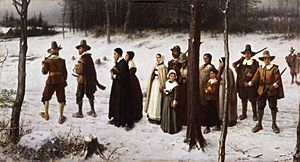Puritan migration to New England (1620–1640) facts for kids
The Puritan migration to New England was a big movement of English Puritans to the New England Colonies. This happened mostly between 1620 and 1640. They traveled in family groups, not alone. Their main reason for moving was to find freedom to practice their religious beliefs.

Contents
The Great Puritan Migration to New England
Why Puritans Left England
In England, there were disagreements about religion. King James I and later King Charles I tried to make peace with the Puritans. Puritans had different ideas about how the church should be run.
A Time of Change and Disagreement
Puritans followed a type of Christianity called Calvinism. They did not like many church rituals. They preferred strong preaching and a different way of organizing the church. This was different from the official Church of England. They felt the Church of England was too similar to older Roman Catholic practices.
This religious tension grew worse when Charles I became king in 1625. He often disagreed with Parliament, the government's law-making body. In 1629, King Charles I closed Parliament. Many Puritans were part of Parliament. With the religious and political situation difficult, many Puritans decided to leave England. Some had already moved to the Dutch Republic in Europe.
The Journey to a New World
A famous journey was the Winthrop Fleet in 1630. It included 11 ships, with the Arbella as the main ship. About 700 passengers sailed to the Massachusetts Bay Colony. People continued to migrate until Parliament met again in 1640. After that, fewer people left England.
The English Civil War started in 1641. Some colonists even returned to England to fight on the Puritan side. Many stayed in England after the war.
About 80,000 people left England during this time. Roughly 20,000 went to New England. Other groups went to Ireland, the West Indies, and the Netherlands. Most immigrants to New England were families. They often had some education and lived fairly well in England. Many came from a region called East Anglia.
Building New Societies in America
A group of Puritans, called Separatists, first went to the Netherlands. They were unhappy with the English church and faced unfair treatment. But they worried their children would forget their English culture. So, in 1620, they sailed to the New World. They founded Plymouth Plantation.
Plymouth and Massachusetts Bay
These early settlers and later Puritan immigrants built a unique culture. It was very religious and focused on community. They hoped their new land would be a special example for the world. They wanted to create a "nation of saints" in America. This would be a deeply religious and good community.
Rhode Island: A Place for Different Beliefs
Not everyone agreed on how to practice religion in the new colonies. Roger Williams believed in religious tolerance. He thought the church and government should be separate. He was asked to leave the Massachusetts Bay Colony in 1635. He then founded Providence Plantations. This later became the Rhode Island Colony.
Rhode Island became a safe place for people with different ideas. Anne Hutchinson was also asked to leave Massachusetts Bay in 1638. She had different religious beliefs. She found a home in Rhode Island. Quakers, another religious group, were also welcomed there. In 1658, a group of Jewish people settled in Newport. They were seeking safety from unfair treatment in Spain and Portugal. Their congregation, Jeshuat Israel, is one of the oldest Jewish groups in the United States.
See also
 In Spanish: Migración de puritanos a Nueva Inglaterra (1620-1640) para niños
In Spanish: Migración de puritanos a Nueva Inglaterra (1620-1640) para niños
- History of Massachusetts
- English Civil War, for more about King Charles I's conflicts.
- Great Migration Study Project


